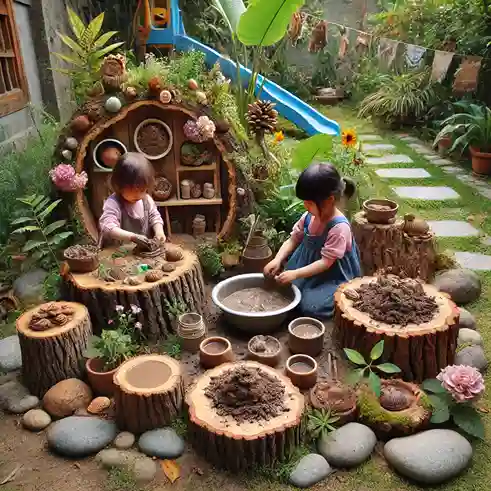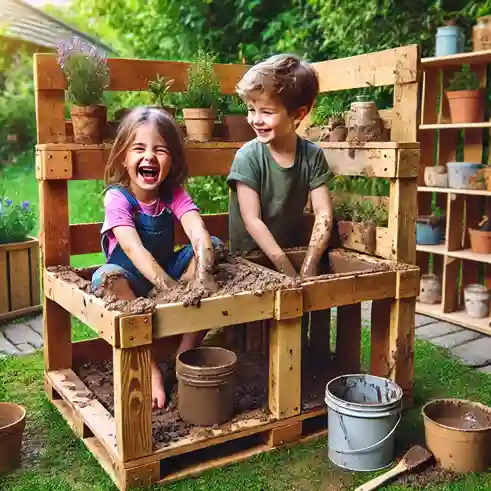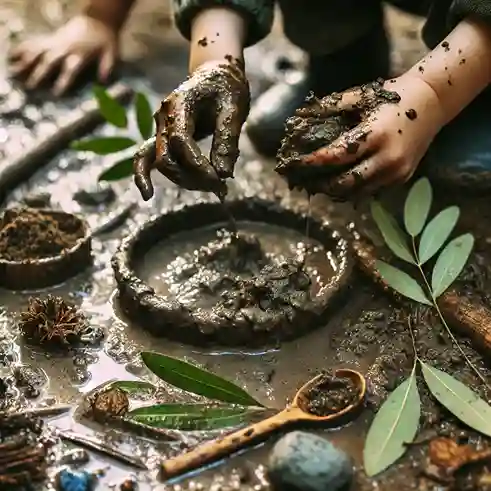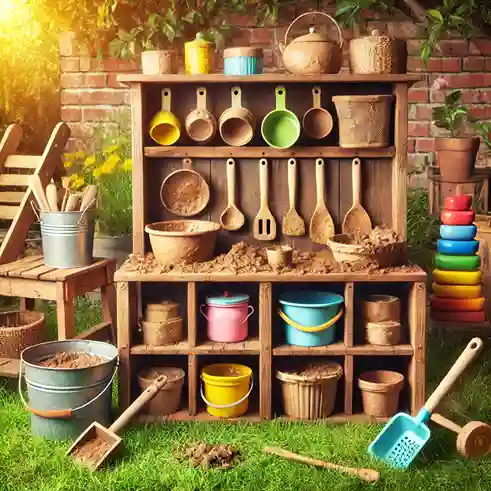Introduction to Mud Kitchen DIY
Mud kitchens, as an adventurous concept in outdoor play areas for children, are approved by most parents and teachers across the globe. These dirty cooking settings enable children to use earth-based content, in particular clay, while engaging in crucial pretend play that extends beyond toy sets for miniature cooking fully occupied inside the house. The core purpose of a mud kitchen is to have a hands-on activity for students that allows them to learn, create, and play with their peers in a larger than enclosed space.
One of the most significant benefits of mud play is its ability to foster creativity in young minds. When using mud, stones, water or leaves as toys children are left with the freedom to play how they wish, engaging in loose play. Pretend play of this nature encourages children to create pretend dishes, stories, and different characters, which most scientists consider exceptional creativity. The raw experience of mud offers children the ability to heighten their sensory awareness and understand how to relate with the world around them.
Among the purposes of mud kitchens is aiding motor development. While toddlers stir, shake and form the mud into various shapes, both gross and fine motor coordination is honed. Manipulative tasks like stirring, digging, and shaping assist in hand muscle expansion, improved dexterity and better coordination with the eye. In later phases, these actions anticipate writing and the handling of utensils which means that mud kitchen diy are not just fun but educational as well.
Children’s development through play in the outdoor space should be viewed as irreplaceable. It offers an important respite from screens, encouraging active health while giving youngsters room to interact, discover solutions to issues, and take controlled risks. The concept of mud kitchen diy strike a great balance between play and learning, hence such structures are an equally important component to have in the backyard, preschool, or any other place where children can play outdoors.
Essential Elements for Constructing your Mud Kitchen

In constructing a mud kitchen diy, the materials that are used should guarantee an enjoyable and safe outdoor play session. All structure is primarily made out of wood which can be obtained from pallets or fresh timber. It is advisable that one avoids using treated wood as this may expose children to toxic chemicals, making the kitchen dangerous. The plywood and some strong wood boards can be used to make the base, countertop, and walls of your mud kitchen diy.
Depending on how advanced you want the cooking to be, pretty much any other pans and pots along with utensils will fit nicely. Kitchen appliances including metal and or plastic mixing bowls, measuring cups, and measuring spoons might help. These can be sourced from unwanted pots and pans or secondhand clothes boutiques, hence sustaining the environment as well as cutting down waste. When purchasing pots and pans, make sure they are sturdy enough to survive outdoor conditions because they will be soaking in moisture and mud.
As an alternative to wooden or plastic pallets, spare equipment, old dish barrels, and other household wastes can be used to make a mud kitchen diy more interesting. Such features can be Aesthetical as well as a supportive aid for play. For example, a log can be used for children to sit on or to support the food preparation requirements. In addition, some green materials like bamboo or recycled plastics can serve to be very beneficial for answering the mud kitchen diy project sustainability requirements.
At the very least, however, all materials should be safe from any sharp edges or dangerous ends. Building items with children can be a great aspect to teach about appropriate use and environmental aspects. If safety and sustainability are ensured, the mud kitchen diy can be a useful imaginary construction site promoting outdoor play and creative engagement among children.
Drafting Plans for Your Mud Kitchen
To ensure a mud kitchen diy serves its purpose and does not look neglected, several aspects of the kitchen need to be taken into account while designing the kitchen concept. To begin with, the size of the kitchen should be suitable for the number of children who will use it together at a go. With a workable arrangement, children can engage in joint play activity which is crucial for their development. The size of a mud kitchen diy might depend from one to the other but in general it should not be too small so that at least two or more children who want to play can fit in without cramping up against the walls.
In terms of layout, it can be said that how the elements of the kitchen are arranged has a great impact on the manner in which the children are likely to play. A division of the kitchen into sections where food can be prepared, cooked and later served should be understood by the children. Try adding cooking toys and potatoes in the cooked area. This area should be easy for them to reach so they do not have to work hard to get it. To add, extra low lying shelves can be provided for storing pots and other cooking toys used when playing pretend games.
Integrating a feature like a water source can increase the interactive element of the mud kitchen diy. A simple faucet connected to a water drum can facilitate the children to rinse off their “ingredients” or make mud mixtures thus enriching sensory interaction. If space allows it, other features like a sandpit or a small planting section can also be incorporated. These additions allow children to engage in more diverse playtime, thereby improving the adaptability of the kitchen.
Safety is another important aspect. Make sure that the mud kitchen’s edges are sufficiently rounded and that any sharp objects that can cause harm can be reinforced. Additionally, if children are to use the outdoor space, make certain that the materials used in the mud kitchen diy are non poisonous, strong, and weatherproof. By considering such safety measures, you can create an artistic and fun-ready mud kitchen diy which children can use to expand and explore their creativity in a safe space.
Step by Step Building Process

Building a mud kitchen diy is a fun and effective work that can be done by adults and children together. A good mud kitchen diy provides an opportunity for children to not only engage in imaginative play but also to experience physical sensations as well. Here is a easy guide showing the steps to follow in order to build mud kitchen diy that will be unique and safe for outdoor use by kids.
First things first, find a nice spot in the yard or garden – you may want this place to be entirely flat and close to water, as it will help you while cleaning. Now grab your mud kitchen diy, and the yard or garden, and remove any unwanted mess or plants. Now grab your measuring tape and carefully measure out the size. A standard “mud” kitchen can range between 3 to 4 feet in length and conveniently stands at roughly waist height so that younger children can access it without assistance.
After figuring out the place and how much space it will take up, collect the required materials. The frame can often be made with wooden pallets or scrap wood, and for the cooker, you can use stainless steel bowls, pots, and mixing spoons. When building the frame, always remember that all the joints are tight. Use screws or nails that are suitable for the outdoors to make sure they can withstand different weather conditions.
It is also a good idea to make a work area as well as a splash area. The work surface area can be constructed with plywood while a splash area can be created by simply putting a plastic sheet underneath the area where the kids will be playing. Of course, always remember that safety comes first so make sure to sand any sharp edges as well as ensure that all parts are finely polished to eliminate any chance of splinters or getting hurt.
Adding a water source makes the mud kitchen diy even more interesting. All you need is a water jug, hosepipe, or even a nozzle if you want a more prominent setup. To finish your construction, the place can also be decorated with stones or plants so that their use adds to the aesthetics as well as the sensory play. Finally, define certain dos and don’ts regarding the use so that it is safe and then sit back as fun erupts in your newly built mud kitchen diy!
Creative Play Ideas for the Mud Kitchen
Perhaps the most beautiful quality of building an interactive mud kitchen diy is the fact that it allows children to spark their creativity and indulge in make-believe games. One of the most enjoyable parts of this outdoor play area is the all-time favorite making of mud pies. By simply mixing together different soils, water, and some organic matter, kids can create their dough-like substances. To increase the fun, encourage children to throw in leaves, flowers, and tiny stones so that they can “cook” delicious meals for their imaginary friends that will engage them in a brilliant creamy adventure.
The children’s IMAGINATION can run wild in the mud kitchen diy expecting to experiment with clay cutting. Role playing is an important part of pretend cooking for children, and this can be done by collecting ingredients from the outside world such as twigs, petals, and even seeds. They can be cooks and tell their friends that they are cooking luxuriant mud food. This activity helps to enhance their narrative abilities and helps them forge a stronger bond with nature as they search for the different items around them.
Water play sounds every bit as amusing as it is, and one can even consider augmenting it with the mud kitchen diy concept. The children will be able to discover the effects of water on different textured materials by mixing mud with water. Through drip trays, and tiny containers one can mix blends, pour or even construct. Water is equally useful in making mud slimes that can heighten the zipper enjoyment while aiding in the cognitive growth of the children.
Thus, the mud kitchen diy is an all in one figurative version of every children’s dreamland for cooking, allowing them to venture as far as their imaginations would take them. By offering a huge variety of natural elements and materials one can improve their children’s outdoor activities tenfold, resulting in infinite amusement and fun.
Outdoor Play Safety Recommendations

Developing a safe experience outdoors for a child would mean developing a mud kitchen diy with safety as its core. First and foremost, sourcing safe and non toxic materials is paramount. Make sure not to use any pressure treated wood which may have leaching chemicals. Such a construction can be done using natural wood or recycled materials that do not undergo hazardous substances treatment. Also, check that any paint or finishing applied is lead free and does not degrade outdoors.
Hard construction is the top priority to avoid incidence. The mud kitchen diy should have enough strength to prevent any kind of accidents, therefore all components need to be tightly fixed and screws should be used instead of nails wherever safe. A strong base will help to prevent topples and subsequent injuries. Other than these, try and avoid any design with sharp edges, or protruding fasteners, as these will increase the chances of cuts or scraping during use. One would expect the mud kitchen diy to have a sign for repairs at regular intervals, as this master piece is prone to wear and tear.
Supervision of children during outdoor activities is highly critical for ensuring their safety. Parents or guardians need to control the general playtime especially when the children are interacting with dirty materials. Math and science based rules, for example preventing materials from being taken outside a set area, or taking unnecessary risks, enhance safety. It is also sensible to use tools and equipment that cater for the age of the children in accordance with their developmental stages.
Do not forget the safety rules regarding the outdoor activities in general. What a child wears on hot days is important in this case as mud clothes are likely to get dirty, and sunblock should be applied as well. Also, pay close attention to the area around the mud kitchen diy. Make sure the location is clean from dangerous elements like sharp stones, broken bottles and poisonous plants. Taking these safety concerns into account in the design and use of mud kitchen diy gives room for kids to play outside more comfortably and safely.
Mud Kitchen Care
The construction of a mud kitchen diy is only the beginning to creating an outdoor environment appealing to children. In order for this functional space to be enjoyed for years to come, it must be maintained, and a good mud kitchen diy maintenance plan is essential. These include the washing or scrubbing of surfaces, attaching any parts that come loose, and even addressing weather damage.
The mud kitchen diy maintenance practice sobers up show a safe and pleasing environment on the overall. Ideally, after each play session, it is wise to try and get rid of any surplus debris such as dirt, vegetation, or food in a bid to avoid pests infestation or mold growth. Most surfaces can be disinfected sufficiently using a simple blot with water, soap and quartering as well if necessary. Make sure that no unused pots, containers, or tools used in the kitchen have not been washed to ensure that hygiene is preserved for children using it. This continual maintenance will not only offer the children a decent environment but also instill good hygiene practices among the young users.
One more important thing to consider while maintaining a mud kitchen diy is securing loose parts as components may get displaced due to wear and tear. It is advisable to make a regular check of the structure and fittings such as screws, hinges and any other bolts that may be loose. Screwing them tight will assure continuous safety of the kitchen. Or perhaps some parts could be treated by waterproof adhesive and sealants to allow active play without the risk of the structure giving way at those points.
Lastly, use the mud kitchen diy as intended outside is a great idea, but don’t forget to consider how the weather might impact it. Depending on where you are located, you may have to take some measures to seal the kitchen wider from the kitchen to prevent it from being soaked in rain, buried in snow or roasted in the sun. When skin is left unprotected, bear leaves unshielded from multi-dimension balance the kitchen. If dry clothes are exposed to the sun, they would only darkness dry soothes the skin use instead garlic cloche to factory the kitchen. With these maintenance tips, your mud kitchen diy can provide a durable and enjoyable play space for children across different seasons.
Entwining Nature with Playtime
As an additional benefit, adding nature to children’s’ playtime helps them in learning and developing a positive attitude towards the environment. In order to make the outdoor play even more productive, a mud kitchen diy can be placed close to the natural features that compliment it. As a suggestion, it might be great to construct a small garden together with the mud kitchen diy where children can grow some herbs or flowers. In this way, an active participation in the gardening activities not only helps them understand the plant cycle, but creates a sense of respect for nature in them.
In addition, a few stones, leaves and logs are likely to add more imagination to the play with the mud kitchen diy. Such features offer children different shapes and textural materials which trigger their imagination during outdoor activities. With the combination of the mud, water and natural objects, children begin to experiment with a variety of combinations which help enhance their fine motor skills and sensory exploration activities. It is quite an interactive or kinetic type of play that helps transition from formal learning approaches to informal contextual learning about the environment.
In addition, the construction of places that allow students to appreciate and interact with local fauna would deepen the relationship with nature. Various species could be lured to the spots by placing bird feeders, butterfly gardens or creating small habitats, hence providing children with a more active educational environment. Interacting with living things may arouse interests and build emotional understanding in children, and such understanding is important in nurturing environmental consciousness in later years.
The inclusion of such components not only makes the play area more enjoyable in terms of immersing children into nature but also reinforces the learning goals concerning environmental and ecological education. Through the use of their mud kitchen diy, children are able to connect with the natural environment in a more practical way, which enables them to be creative and curious while also fostering a greater love for nature.
Conclusion and Call to Action
Building a gardening kitchen is more than just creating an interesting space to play in the outdoors; it is an opening to provoke young children’s fantasies and creation’s aesthetics through the sense of touch. This imaginative play area not only requires power of imagination as children mix, stir and bake various types of food, but it also supports constructive play where children learn through their senses. Furthermore, engaging in mud play and naturalistic play enhances fine motor skills and problem solving skills because children use their imagination while creating structures out of the given resources.
Being parents and guardians, let it be the case that one should not take a mud kitchen diy creativity as a regular future of a child’s outdoor creativity sandbox. The setting is appropriate for free play, which helps children socially when they play together and work. The possibilities of materials children can work with – in this case it is water, sand, leaves, pebbles – heightens the senses even more in a sensory rich environment that is created by the gardening kitchen. It connects nature with play, directing a thought to protect the environment while satisfying all the developmental aspects.
Explain to me once again how the idea of mud kitchen diy has become so popular in commencing outdoor play for kids. It’s all about feeling natural, isn’t it? It is now absolutely appropriate for you to start working on the construction of your own mud kitchen diy! Start preparing everything for a creative mess outdoors – you can take your kiddos along as well to have a blast generating the excitement themselves! The advantages of either having a complete kitchen or a dirty place in which to play are immense. Those of you who love mud kitchen diy can upload the pictures and experiences of any new ideas you try out within your local community or social media. Such contributions can motivate other families to take up such creative ideas, allowing the future generations to become more inventive and active.

